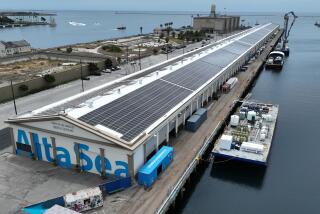Sunny Side Up : Los Angeles Lighthouse Will Be the First in California to Use Solar Power to Keep Its Lamp Lit
They are pulling the plug on the historic Los Angeles lighthouse, but it is unlikely many people will even notice.
The distinctive white and black tower at the mouth of Los Angeles Harbor, whose flashing light has guided thousands of mariners for three-quarters of a century, is being converted from electricity to solar power.
The move comes as the Coast Guard, which operates lighthouses and other navigational aides nationwide, is placing greater emphasis on solar energy as a cost saving alternative to traditional sources of power, Coast Guard officials said.
The Los Angeles lighthouse will be the first traditional lighthouse in California to rely on sun as its source of energy, according to the U.S. Lighthouse Society in San Francisco. Other navigational aides, such as buoys and lights not in traditional houses, are already solar powered, as are traditional lighthouses in other parts of the country.
For years, the lantern, fog horn and radio beacon at the Los Angeles lighthouse were powered by an electrical cable that ran two miles from Cabrillo Beach along the San Pedro Bay breakwater to the lighthouse, which is so far from shore that its keepers were sometimes stranded there for days during storms.
The cable was knocked out when winter storms in 1982 and 1983 destroyed several sections of the breakwater. Since then, the lighthouse has been powered by its back-up diesel generators, which actually were the lighthouse’s original power source.
In the next few weeks, the generators will be disconnected and several dozen solar panels will be set up on the roof of an adjacent storage building. By the end of August, the lighthouse should be running solely on solar power, the Coast Guard said.
Similar conversions of lighthouses in New England, which has the highest concentration of lighthouses in the country, have been highly successful, said Petty Officer Ken Arborgast, a spokesman for the Coast Guard in Boston. The Coast Guard has converted 16 of the 102 lighthouses in Maine, New Hampshire, Massachusetts and Rhode Island, he said.
“Most of them are on islands or remote rocky points,” Arborgast said. “They originally tried to use electricity, but they had problems with the cables. The storms and tides would just pull them up.”
The energy switch at the Los Angeles lighthouse--at the entrance to one of the nation’s busiest harbors--is also expected to go smoothly. Lt. Bill Meyn, who is overseeing the conversion for the Coast Guard, said it will result in minor changes to the basic functions of the lighthouse.
The green lantern atop the 73-foot-high tower will continue to flash every 15 seconds, and the fog signal will still sound a series of three two-second blasts every 30 seconds, he said. But both the lantern and the fog signal will have reduced intensity. The new lantern, for example, will have a maximum visual range of 15 miles, four miles less than the current lantern. Meyn and others said most skippers will be unable to detect the difference since they generally rely on the lantern and fog signal when relatively close to shore.
“It doesn’t change a thing,” said Capt. Jackson Pearson, chief port pilot for the Port of Los Angeles, whose only concern about the conversion was that the green lantern not be abandoned. Pearson, whose staff escorts ships into the harbor, said the green signal has become the hallmark of Los Angeles, distinguishing it from other West Coast ports.
“The green light has been traditional, and we don’t want to lose any history if we don’t have to,” Pearson said. Most other lighthouses have white lamps.
The Coast Guard will turn the green lantern over to the Los Angeles Maritime Museum in San Pedro, but the Coast Guard has agreed to place a green lens in the new solar-powered lantern, Meyn said.
The most significant change at the lighthouse, which involves its radio beacon, already has taken place.
Because the new solar-powered batteries will not be powerful enough to operate the lighthouse’s sequenced radio beacon, the beacon last month was moved about 25 miles northwest to the Point Vicente lighthouse in Rancho Palos Verdes.
The sequenced radio beacon is used by mariners to plot their course in conjunction with two other beacons in Southern California: at Point Loma in San Diego and Point Arguello in Santa Barbara County. All three beacons transmit in sequence on the same frequency, allowing passing ships to get a triple navigational fix without changing the tuner.
At its new location high on the coastal bluffs at Point Vicente on the Palos Verdes Peninsula, the sequenced radio beacon has a range of 140 miles--nearly double the range it had at Los Angeles lighthouse, Meyn said. The new Point Vicente beacon operates on a 302 kilohertz frequency with the Morse code letter V.
The Coast Guard has replaced the sequenced radio beacon at the Los Angeles lighthouse with a shorter-range beacon that can be transmitted by solar power. The new beacon operates continuously, rather than in a sequence, at a 325 kilohertz frequency with the Morse code letters LA. It has a range of 15 miles.
“The guys most likely using the Los Angeles light(house) beacon want to go to Los Angeles, so providing them with a continuous signal will be an improvement,” said Meyn, who has briefed several boating and shipping groups in the harbor area about the changes. “We think it is a good change, because it will provide a better signal for those coming to Los Angeles.”
No Complaints
Port and Coast Guard officials said they have received no complaints about the changes.
Aside from the navigational considerations, the shift to solar energy will save the Coast Guard money and, Coast Guard officials expect, provide a more reliable power source. Meyn said the agency considered replacing the electrical cable, but soon discovered it would be too costly and too risky.
When the breakwater was built in 1910, it was constructed with carved, rectangular granite slabs that stacked neatly and provided a convenient ledge for the electrical cable and its conduit. But the Army Corps of Engineers, unable to recover the carved slabs knocked out during the storms, eliminated large segments of the smooth ledge when it replaced the missing slabs with piles of jagged rocks, known as riprap.
“We had an extremely reliable system, but we don’t feel that we have that anymore,” Meyn said. “We would have to go over the five or six places where there is riprap. The primary cause of outages in Southern California is subcable failure in that kind of situation, such as shifting rocks as a result of a storm.”
The Coast Guard estimated that it would cost $60,000 to replace the electrical cable and the small Coast Guard power station at Cabrillo Beach that was also damaged in the storm. For about $45,000, the agency can convert to solar energy, add a new radar navigational aid on a buoy near the lighthouse and provide the radio beacons at Point Vicente lighthouse and at the Los Angeles lighthouse.
The cost of maintaining the diesel-powered generators also eliminated them as a permanent solution to the lighthouse’s energy needs, Meyn said. Fuel alone costs about $4,000 a year, he said, and the equipment requires regular maintenance and monitoring.
The five-story lighthouse, which includes a kitchen and sleeping quarters for four, has been unstaffed since 1971, meaning the Coast Guard would need to provide regular maintenance crews. In addition, diesel fuel poses fire and environmental hazards that solar-powered batteries do not, he said.
The conversion to solar energy at the Los Angeles lighthouse probably will not lead to a massive effort to convert other lighthouses throughout California, Meyn said. Some lighthouses--such as one on Anacapa Island--are likely candidates because of their remote location, but he said the Coast Guard will not abandon commercial electrical power where it is readily available.
Wayne Wheeler, who heads the lighthouse society in San Francisco, said most major lighthouses in California will never be converted to solar energy because their lamps are too large to be powered by the sun.
“Lights with ranges of 20 to 25 miles for the most part require commercial power,” Wheeler said. “In Los Angeles, you don’t have that problem because you don’t need a 25-mile light. . . . You really don’t have that much reduced visibility.”
More to Read
Sign up for The Wild
We’ll help you find the best places to hike, bike and run, as well as the perfect silent spots for meditation and yoga.
You may occasionally receive promotional content from the Los Angeles Times.






